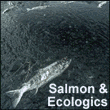forum
library
tutorial
contact

Latest NMFS Analysis on
Seasonal Barging Strategy
by Bill Rudolph
NW Fishletter, March 29, 2013
|
the film forum library tutorial contact |

|
Latest NMFS Analysis on
by Bill Rudolph
|
The analysis found he most important covariate effect on wild spring Chinook
was water temperature, then coastal upwelling, smolt passage index, and spill.
Federal scientists from NMFS' Science Center in Seattle say their latest analysis of fish transport clearly shows benefits during the month of May over young salmonids that pass federal dams on the lower Snake River via bypass systems. But their analysis doesn't really answer a bigger question--whether barged fish return at higher rates [SARs] than fish that pass dams via spillways.
But in their final report released earlier this month, "A Study to Determine Seasonal Effects of Transporting Fish from the Snake River to Optimize a Transportation Strategy," the scientists were clear that their analysis would not answer that question. In response to a reviewer's comment of an earlier draft, they pointed out that "No data exist to make direct within-season comparisons of SARs for collected and transported fish and SARs of fish that pass via spill. Our results are applicable to within-season management decisions concerning spill to the degree that the SARs for bypassed fish continuing migration in-river can be extrapolated to SARs for fish that avoided transportation by passing other routes."
The study is an update from a 2009 analysis and includes survival data collected since then. It also uses an alternative standard that tries to capture the relative benefit of transported spring Chinook and steelhead to the run-at-large, which includes a large component that pass dams via spillways, and are never detected, rather than just measuring the ratio of transported SARs to those of fish that pass the dams via bypass systems and are returned to the river.
According to the report, the correction factors built into the alternative standard "raised the bar" to a higher standard than a T:B of greater than 1, which indicates a survival benefit of barging over bypassed fish.
Depending on the year, the use of the alternative standard showed that transported wild Chinook needed SAR that was 1 percent to 3 percent higher than the non-detected fish to show a benefit from barging, and a 3 percent to 12 percent higher SAR for transported wild steelhead before it was beneficial. For hatchery fish, the analysis showed SARs for transported hatchery Chinook had to be 7 percent to 14 percent better than undetecteds to be beneficial, while SARs for transported hatchery steelhead needed to be 9 percent to 25 percent higher than undetected fish to show a benefit.
The analysis reported that before 2006, the T:B ratio nearly always exceeded the alternative standard for fish that reached Lower Granite Dam or later, Since then, when a court-ordered spill regime was implemented that kept spill and transport going regardless of flow conditions, the analysis said there have been no "radical departures" in the T:B ratios observed in prior years. But the scientists found that T:B ratios of hatchery steelhead may have changed--"the only instances of significantly lower returns for transported hatchery steelhead occurred in the early parts of the 2007 and 2008 migration seasons," but they noted that the T:B exceeded 1 by May 10 in both years.
"It is difficult to determine at this point whether altered spill operations and returning all bypassed smolts to the river during the early part of the migrations in 2006-2009 have resulted in changed T:B ratios, compared to earlier years," said the report, which noted that some weekly T:B ratios were apparently lower early in the season. They said final results will not be completed for another year or two, when all adult fish from these years have returned.
The analysis found that annual (geomean) average SARs for transported fish were higher than for bypassed fish for both spring Chinook and steelhead from all dams. Excluding the extremely low-flow 2001 migration year, when few fish survived inriver, transported fish had an overall 28-percent benefit, while barged steelhead SARs were more than 3 times higher than for bypassed steelies. There was also a difference in SARs, depending whether the fish were tagged at Lower Granite or above it. Fish tagged at the dam exhibited somewhat lower SARs.
The report also looked at other factors that might be influencing SARs of the wild and hatchery fish. The analysis found the most important covariate effect on wild spring Chinook was water temperature, then coastal upwelling, smolt passage index, and spill. For hatchery Chinook, the important covariates were not similar over all the years examined (since 1999), but water temperature seemed to play the most important role, on average.
Wild steelhead SARs also showed various covariates played roles across the years examined. Water temperature ranked the highest in weight, followed by flow, spill, smolt passage index, and coastal upwelling. Various factors seemed to play important roles in influencing hatchery steelhead SARs from year to year, but were similar to effects on wild steelhead.
The scientists said, in future reports, they will look at the possibility of using some covariates to forecast when barging fish would likely be most effective at increasing SARs. They said a two-week to four-week prediction window would be essential for such a strategy to succeed.
learn more on topics covered in the film
see the video
read the script
learn the songs
discussion forum
